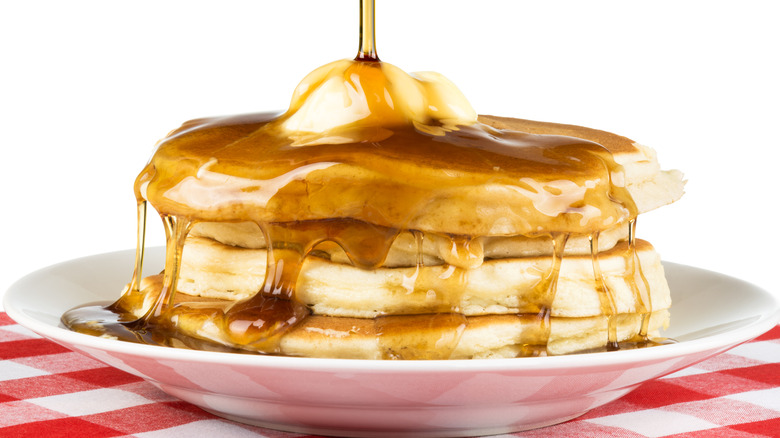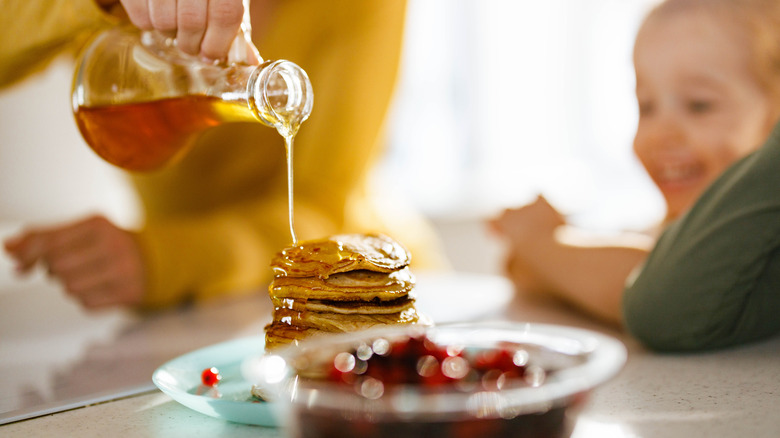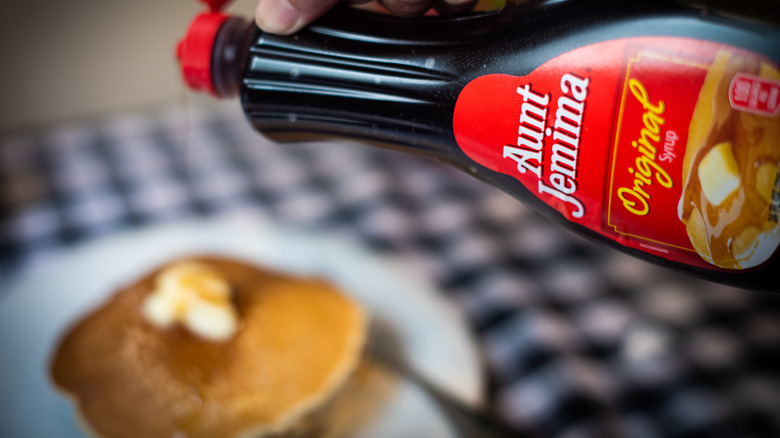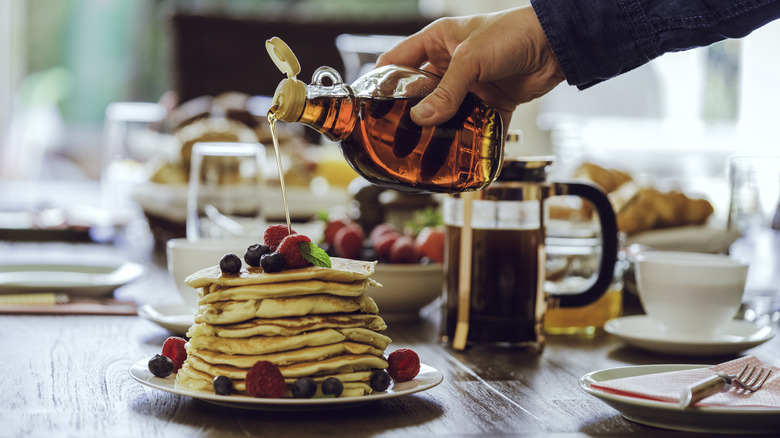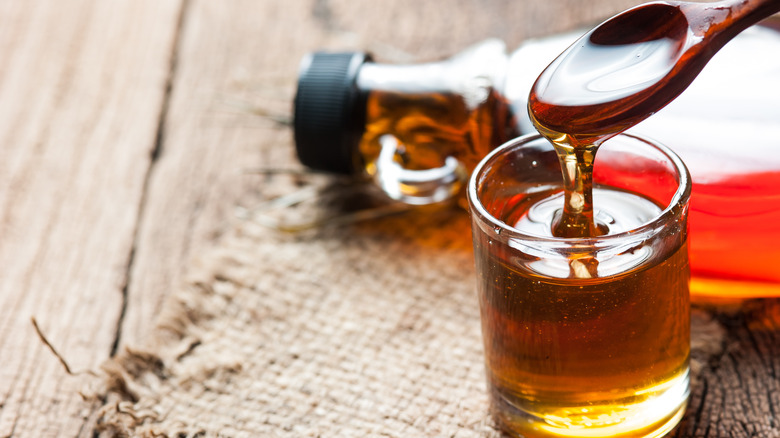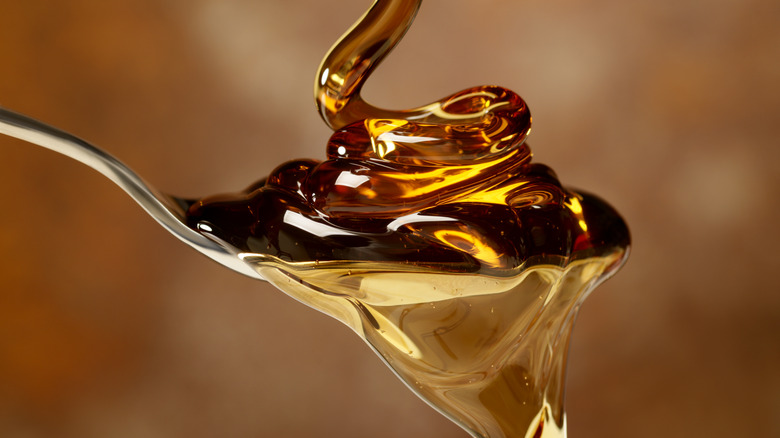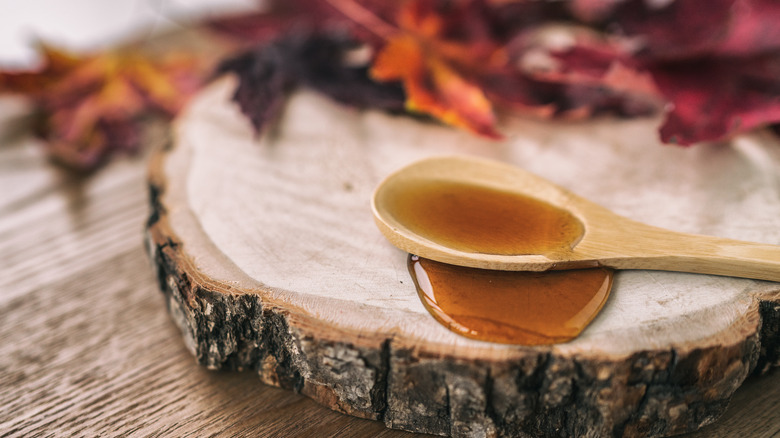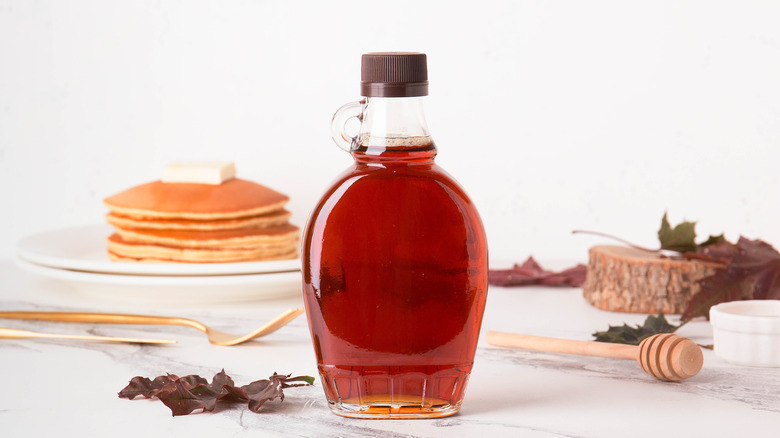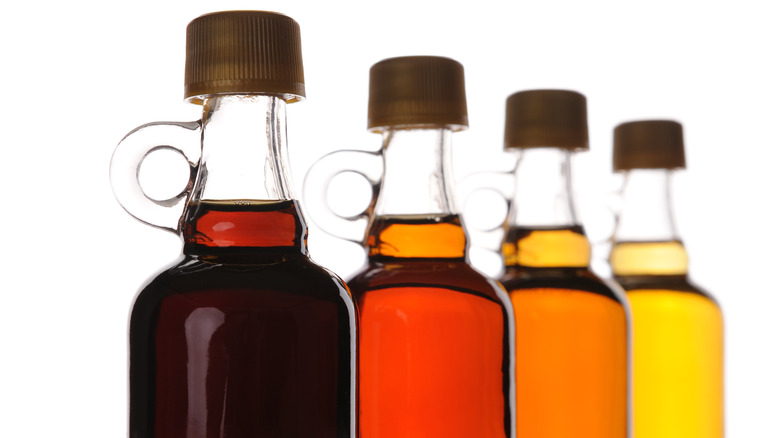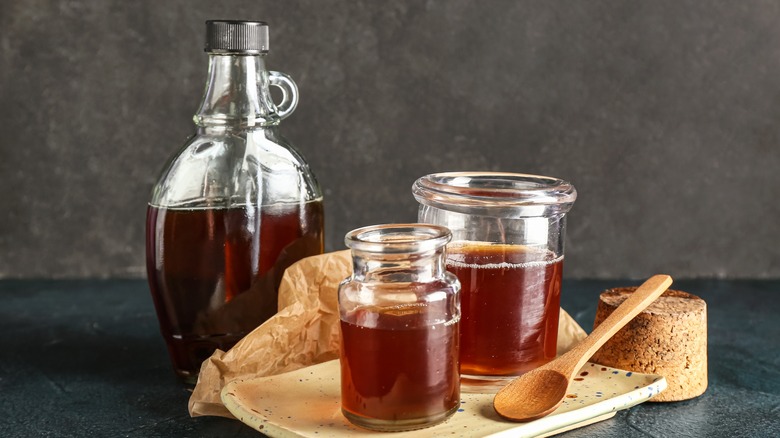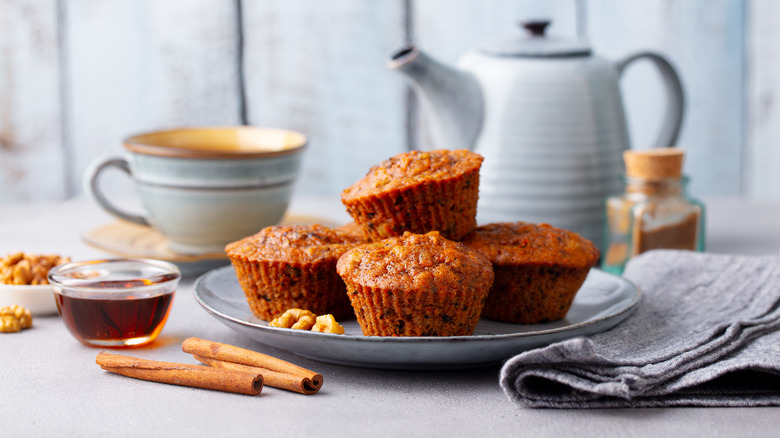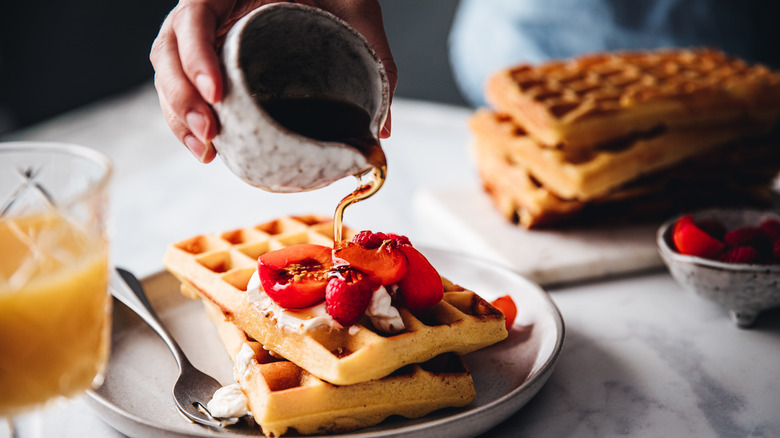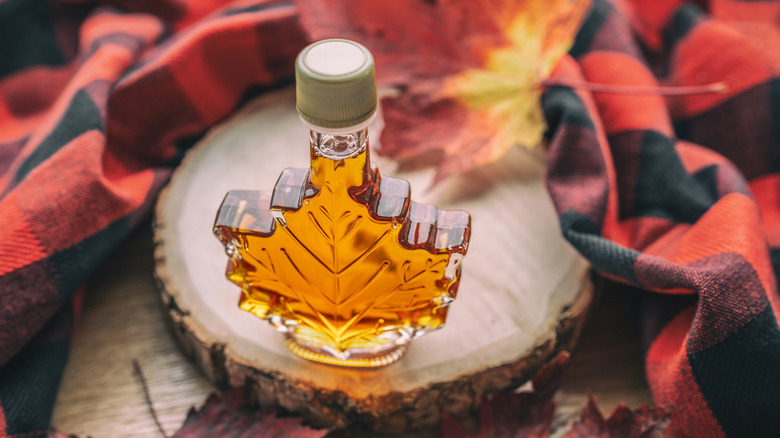Here's The True Difference Between Maple Syrup And Pancake Syrup
For the unacquainted, maple and pancake syrup may seem the same. The two products usually take up the same shelf space at grocery stores, and pancake syrups are often promoted as a cheaper, more accessible replacement for the pricy maple syrup. This often leads to confusion, with many wrongly assuming that, at its basic, these syrups are identical.
The two share some similarities and are generally consumed in a similar fashion. They have comparable consistency and are mainly used as sweet toppings, frequently drizzled over pancakes, French toast, and waffles. Both are ubiquitous in American cuisine and can be good sweeteners or a convenient substitute for sugar in sweet and savory dishes. But this is where the similarities end.
The two syrups are entirely different products, and it is a good idea to learn how to differentiate between them. Do not fall for the absurd ideas suggesting that the package or the price are the apparent indicators of how to recognize authentic maple syrup. The easiest way to tell the difference is to read the label. Maple syrup will list only one ingredient while pancake syrups can be easily recognized by the long ingredient list squeezed at the back of the label. Besides the ingredients, there are many other technicalities and features that clearly show the true difference between the two syrups.
Everything inside maple syrup is natural
Although it goes through some processing, maple syrup is an entirely natural ingredient. In its raw form, maple syrup starts as sap collected from maple trees. Not all maple trees in North America are suitable for maple production. Only a handful of species, such as the black and sugar maple, will produce the maple sap.
The sap starts as sugar that has been produced during the summer. It is concentrated in the roots for the dormant winter period. As the temperature rises, the sugar transfers throughout the plant and flows through the incised holes or the placed taps that are inserted in the trunk.
Raw sap has high water content and needs to be cooked down. As the liquid is cooking, the water will evaporate, turning the sap into a thick syrup with concentrated maple flavors. The syrup is then ready for distribution. This means everything inside the true maple syrup is completely natural, without added preservatives and colorings.
Pancake syrups are highly processed
Unlike maple syrup, pancake syrups are not based on natural products and ingredients. The base of many store-bought pancake syrups usually starts with corn syrup and high fructose corn syrup. The two have similar names but are not the same in terms of production and function. Corn syrup is produced from cornstarch and usually calls for other ingredients to make the light or dark viscous syrup that can later be used in food production.
High fructose corn syrup is also derived from cornstarch, but unlike corn syrup, which is a product classified as 100% glucose, in high-fructose corn syrup, some of the glucose is transformed into fructose. High-fructose corn syrup is usually used as a sweetener in various packaged goods where it is classified as added sugar. This syrup is notorious for its relatively poor nutritive profile and the negative effects it can have on your health and general well-being.
Apart from these syrups, pancake syrups usually incorporate cellulose gum, caramel color, and other additions and flavorings. Essentially, most ingredients that make pancake syrups are processed or derived from other products, which is in contrast to the all-natural ingredient bill and minimal processing used to produce real maple syrup.
The real difference is in the flavor
Besides the significant difference in ingredients — maple and pancake syrups differ in flavor. Apart from boiling the sap to lower the water content, maple syrup undergoes minimal processing. The authentic syrup will not include any additional flavorings or artificial ingredients. This practice is reflected in the flavor that is always clean, well-balanced, and unobtrusive, primarily dominated by those pleasant maple notes.
On the other hand, as generic pancake syrups are heavily processed, they need to include flavorings that will try to imitate the natural maple flavor. Many big labels only list that the brand uses artificial and natural flavorings but rarely specify the exact ingredients added to the formula. Though these pancake syrups do a relatively good job mimicking the profile of genuine maple syrup, they can't compare in the flavor department. Sweetness is the dominant element in artificial syrups, and they always come off as somewhat one-dimensional, missing those complex nuances that maple syrup is known for.
Two syrups have a slightly different consistency
Apart from flavor, a quick glance at these syrups will reveal that their consistency is not the same. This difference is again mainly due to the combination of ingredients packed inside the bottle.
Both types of corn syrups that are generally used to make the base of pancake syrups have a quite distinctive texture. They are thick, sticky, and almost gluey, suggesting that the pancake syrup will have similar qualities. Even after all other ingredients have been added, pancake syrups retain that gooey quality that is easy to distinguish as it oozes at a very slow pace and has a thick, compact flow.
On the other hand, authentic maple syrup starts as a quite runny tree sap. To attain its qualities, producers have to use various boiling techniques to let the water evaporate, transforming the watery tree juice into a product with a thicker, syrup-like consistency. However, maple syrup is never cooked to reach the same texture as processed pancake syrups. It will always be slightly thinner and glide more freely on those stacked pancakes, soaking in beautifully.
Maple syrup is actually sweeter than pancake syrup
When reading through the production techniques and olfactory characteristics of maple and pancake syrups, one might assume that authentic maple syrup is less sweet than factory-produced pancake syrups built on processed ingredients and artificial flavors. In reality, things are the other way around.
When looking merely at the sugar content, maple syrup is, at its core, the sweeter of the two. One serving that equals 1/4 of a cup or 83 grams packs a massive 50.2 grams of total sugar. Most of it, precisely 48.4 grams, is taken up by sucrose, which is just plain sugar. Only a tiny percentage of the total number falls on glucose and fructose.
On the other hand, the same serving of Mrs. Butterworth's Original syrup has less sugar, coming at 24 grams per two tablespoons, which would be about 48 grams of sugar for a quarter cup of syrup. Surprisingly, the original Aunt Jemima Syrup goes well below those numbers, with 35 grams of sugar for the same serving. Of course, it is always recommended to investigate where the sugar comes from and in which form it appears in food, but essentially, maple syrup will have a slightly higher sugar content.
But maple syrup has an overall better nutritional profile
Despite the higher sugar content, maple syrup is generally the superior option if you take a closer look at the nutritional profile of the two types of syrups.
Because maple syrup is created naturally, it seems logical that it packs more beneficial nutrients. One tablespoon of maple syrup will deliver several essential minerals to your body, such as potassium, iron, magnesium, and calcium. The amounts are small but still can be a welcomed addition to add up to the required daily intake. Apart from minerals, maple syrup packs more than twenty antioxidants, which can be beneficial in the prevention of inflammation and serious diseases.
In comparison, pancake syrup can immediately be classified as the low-grade choice in terms of nutrition, mainly because of the two main ingredients that usually make up the biggest part of these syrups. High fructose and plain corn syrups have no nutritional benefit or any nutritive value — and are generally thought to be ingredients that should be avoided and removed from the diet. If you are looking for a healthier alternative, maple syrup is, by all accounts, the better choice in this duel.
Both syrups should be used sparingly
Despite numerous differences between maple and pancake syrups, one common characteristic of both varieties relates to how often you should indulge in these syrups.
You might have already assumed that the advice here is to stay clear of both or reduce consumption as much as possible. Although maple syrup packs some beneficial nutrients and minerals that can positively affect your health, it is a problematic choice due to the massive sugar content — a standard serving of maple syrup will pack approximately 60% sugar, which is a colossal percentage. Essentially, you can think of maple syrups as a healthier sugar alternative due to the additional nutrients, but it should not be classified as a superfood or super healthy ingredient.
Pancake syrups, however, include all that added sugar and, on top of that, miss out on the minerals. Not to mention that the ingredient list may be troublesome as most elements are artificially produced. The result of high processing is also evident in the high amount of ill-famed sodium — two tablespoons will pack approximately 80 milligrams of sodium, which is 3% of the recommended daily intake. That may not seem like much, but as so many of the foods we eat contain added sodium, every bit really does add up.
Maple syrup has a strict color gradation
If you have ever explored the complicated world of maple syrups, you have probably noticed that there can be significant color differences, ranging from light, golden-hued versions to dark, almost pitch-black examples. The color is not an indicator of quality or authenticity. The gradation is natural, and authentic maple syrup can take on different tones depending on several factors in the production process.
Since 2015, there has been a universal, international gradation system that divides all maple syrup into two main categories; the processing grade available only for commercial use and grade A, divided into four subcategories. The mildest grade A is labeled as Golden Delicate. This is the lightest version, with the most nuanced flavor, best used as a topping on dishes that call for delicate maple flavor. It is followed by Amber, a grade with a slightly darker color and more intense flavor that makes the perfect all-rounder option. The third version is Dark maple syrup with more toffee notes reminiscent of caramelized brown sugar that is suitable as a table syrup and is ideal for cooking. The last on the list is the Very Dark type, which should only be used as an ingredient.
Pancake syrups are not subjected to a similar gradation and do not follow any rigid classification system. This means there are no universal characteristics that would aptly describe pancake syrups or detailed guidelines that would apply to all labels.
There is a reason why real maple syrup is more expensive than pancake syrup
The obvious difference between the two syrups is immediately noticeable at the store. Just a quick glance at the syrup shelf reveals a disproportionate price difference. By rule, maple syrup will be the more expensive version. And though some might find this discrepancy somewhat surprising, there is a legitimate reason why maple syrup is always priced higher, and it all comes down to two entirely different production processes.
As explained, maple syrup starts as a tree sap, but to produce it, the trees must be over 30 years old and require ideal climate conditions. Additionally, the sap only appears during the season, which lasts roughly from four to six weeks per year. This means that even the beginning of production calls for an astonishing amount of time and ideal conditions that are not easily fulfilled. Finally, the sap needs to be collected and processed, which also requires time and skill, implying that the entire process is straining, pricey, and labor-intensive. The reason why maple syrup dictates such high prices is perhaps best explained by the fact that one mature tree produces around ten gallons of sap, which will make one quart (approximately one liter) of syrup in a given season.
On the other hand, the production of pancake syrup is entirely mechanical and uses cheap materials in the process. Naturally, the price will reflect the significantly cheaper production method.
Maple syrup is a better option for cooking and baking
When it comes to cooking, both syrups can be used in sweet or savory dishes, but due to their qualities, maple syrup will perform better as it will deliver more character and complexity. Due to the unfavorable use of corn syrups, artificial flavorings, and preservatives, pancake syrup will not provide much in the flavor department. The somewhat one-dimensional flavor profile will quickly dissipate in the cooking process. However, pancake syrups can provide sweetness, so they make a suitable sugar substitute.
On the other hand, maple syrup will hold up better in the kitchen. The nuanced maple flavor will work with various other ingredients, and the rich, complex profile will come through in dishes that require long processing. Additionally, you can always adjust the grade and the type of maple syrup depending on its potential use in the kitchen. For any dishes that will be more exposed to heat, go with the amber-colored version that has a fuller, more pronounced flavor, and reserve the light varieties for equally delicate dishes that do not call for extensive processing, such as marinades, glazes, dressings, sauces, or dips. This is where maple syrup can reveal its full potential and allow the flavor to shine.
Americans prefer processed pancake syrups over the real maple version
Though maple syrup generally ranks higher than pancake syrups in all aspects, it seems that the artificially made pancake syrup still has a devoted and loyal fan base among Americans.
In a Google Customer Survey panel that investigated which pancake topping was an all-American favorite, pancake syrups ranked higher than real maple syrup. The survey included more than 1000 participants, and the vast majority — a whooping 70% — opted for popular syrup brands such as Aunt Jemima, Mrs. Butterworth's, Log Cabin, and Hungry Jack as their preferred syrupy choice for pancakes. Only 25% regard the true maple syrup as the superior pancake garnish (via Washington Post).
These results should not be surprising, as essentially, it all comes down to personal taste. Perhaps you have been raised on classic pancake syrups, and you regard its flavor as the accurate version as it is already familiar to your taste buds. In this case, the authentic maple syrup may seem a tad overwhelming, regardless of its unquestionable quality. Conversely, if you have learned to appreciate the nuanced character of genuine maple syrup, you will probably classify pancake syrups as overly sugary and too artificial in flavor and texture.
Maple syrup needs to be refrigerated after opening
The last thing on the list that separates pancake and maple syrup is the way these two staples should be stored. Essentially, we have to return to the beginning of the story, all the way to the manufacturing process and to the list of ingredients packed inside the syrup bottles.
If maple syrup is your preferred choice, you probably know that the bottle holds only maple syrup, without additives and preservatives that can affect the expiration date. And though maple syrup has a relatively long shelf life due to the high sugar content that acts as a preservative, it is more susceptible to spoilage than similar, artificially produced syrups. Unopened, it will be good for a couple of years, but store it in a cool place without much sunlight. After opening, maple syrup should be refrigerated as germs may travel to the bottle, creating a rather unappetizing moldy layer.
Most store-bought pancake syrups are highly processed and packed with preservatives that stabilize and extend the shelf life of all processed foods. This means you can leave that syrup at room temperature after it is opened, and you probably won't see any mold. However, many brands will suggest refrigeration just to be on the safe side. Before the syrup is opened, it should be kept in a dark and cool place but does not require refrigeration.
